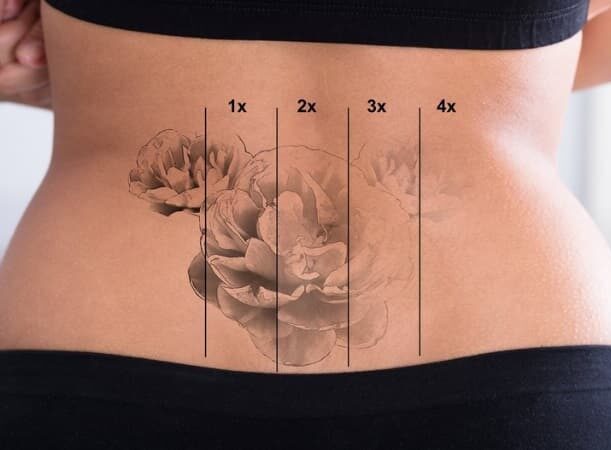Sometimes people get tattoos that seem like a good idea at the time, but later on, they no longer love them as much as they used to. Laser tattoo removal may be the perfect solution for those contemplating getting rid of their tattoo or having any regrets about an old tattoo. This procedure uses laser energy to break down the ink in their tattoo, which is then absorbed by their body and eliminated. This blog post will go over everything people need to know about laser tattoo removal, from what it is to how it works to what patients can expect during and after their treatment.
What is Laser Tattoo Removal, and How Does it Work?
Laser tattoo removal uses a Q-switched laser to break down the ink particles in the patients’ skin. The light from these lasers is absorbed by pigment or color in the skin, breaking it into tiny fragments. These ink fragments are then eliminated through their body’s natural elimination processes, or they may stay trapped under the skin if the fragment is too small to be eliminated.
The laser tattoo removal process begins by first numbing the area with a topical anesthetic. Once the area is numb, the technician will begin treatment. The laser will be passed over the tattoo repeatedly until all of the ink has been broken down. Depending on the size and complexity of the tattoo, the treatment can take anywhere from a few minutes to an hour.
There are some limitations to laser tattoo removal and what it can treat. For example, black ink is the easiest type for lasers to remove, while yellow and orange inks are much harder because they absorb less light energy than other colors. Green tattoos are also difficult to treat because this color absorbs both the red and yellow light used in laser treatment.
People with darker skin will have a harder time getting good results from laser tattoo removal, although it can still be done. In these cases, the technician may use a different type of laser, such as an IPL or PicoSure. This is because people with dark skin have more melanin in their skin. Unfortunately, the laser can’t distinguish between the tattoo ink and the melanin in the body, which means it will also break down some of their natural pigment when treating them for tattoo removal. When this happens, there is an increased risk of hyperpigmentation or hypopigmentation, which means their skin will become darker or lighter than the surrounding area after treatment.
The Benefits of Laser Tattoo Removal
There are many benefits of laser tattoo removal. One benefit is that it allows people to get rid of tattoos that they no longer like or don’t want anymore because their tastes have changed over time. Another benefit is that most patients who undergo this procedure will not experience any complications from treatment- making for less downtime and a quicker recovery.
Additionally, laser tattoo removal is a much safer option than other tattoo removal methods, such as dermabrasion or surgery. With laser treatment, there is minimal risk for scarring and infection. The lasers used in this procedure are also very precise, which means that they can target the ink particles without damaging the surrounding skin.
Lastly, laser tattoo removal is a more affordable option than other tattoo removal methods. The cost of the procedure will vary depending on the size and complexity of the tattoo. Still, it is generally less expensive than getting a cover-up or removing a tattoo with surgery.
How to Prepare for a Laser Tattoo Removal Appointment
In order to get the best results from a laser tattoo removal treatment, it is important to prepare correctly. The first step is to avoid sun exposure in the days leading up to the appointment. This means that a patient should avoid going out in the sun, using tanning beds, and wearing sunscreen.
The second step is to ensure that the area is clean and free of any oils or lotions. If there is anything on the skin, it will absorb less of the laser’s energy and make it more difficult to remove the tattoo.
The third step is to avoid having a tan or sunburn on the treatment area. This is because tanned skin absorbs more of the laser’s energy, which can cause burns and scarring.
Lastly, the patient will need to avoid taking Aspirin or any other blood thinners in the days leading up to their appointment. This is because they can increase the risk of bruising and bleeding after treatment.
If these guidelines are followed, they should have a much easier time preparing for their laser tattoo removal appointment.
What to Expect After the Treatment
After the treatment is complete, the patient will be given instructions on caring for the treated area. They will likely need to keep the site bandaged and clean until it has healed. Most people experience some swelling and redness after their treatment, but this usually lasts only a few days.
The Cost of Laser Tattoo Removal
The cost of this procedure will vary depending on the size and complexity of the tattoo. Still, it is generally less expensive than getting a cover-up or removing a tattoo with surgery. The average price range is between $400-$800 per session, and some people may need several sessions to remove the tattoo completely.
The cost of laser tattoo removal can be expensive, but if someone wants to get rid of an unwanted or unattractive tattoo, it may be worth it to achieve their goal. The best way to determine how much this procedure will cost is by scheduling an appointment with a dermatologist specializing in laser treatments.
Looking for Tattoo Removal near New Braunfels or Austin, TX? Newman & Co. has specialists that can do the job! They can be reached at 866-905-7005 or on their website https://newmancmpy.com/.














